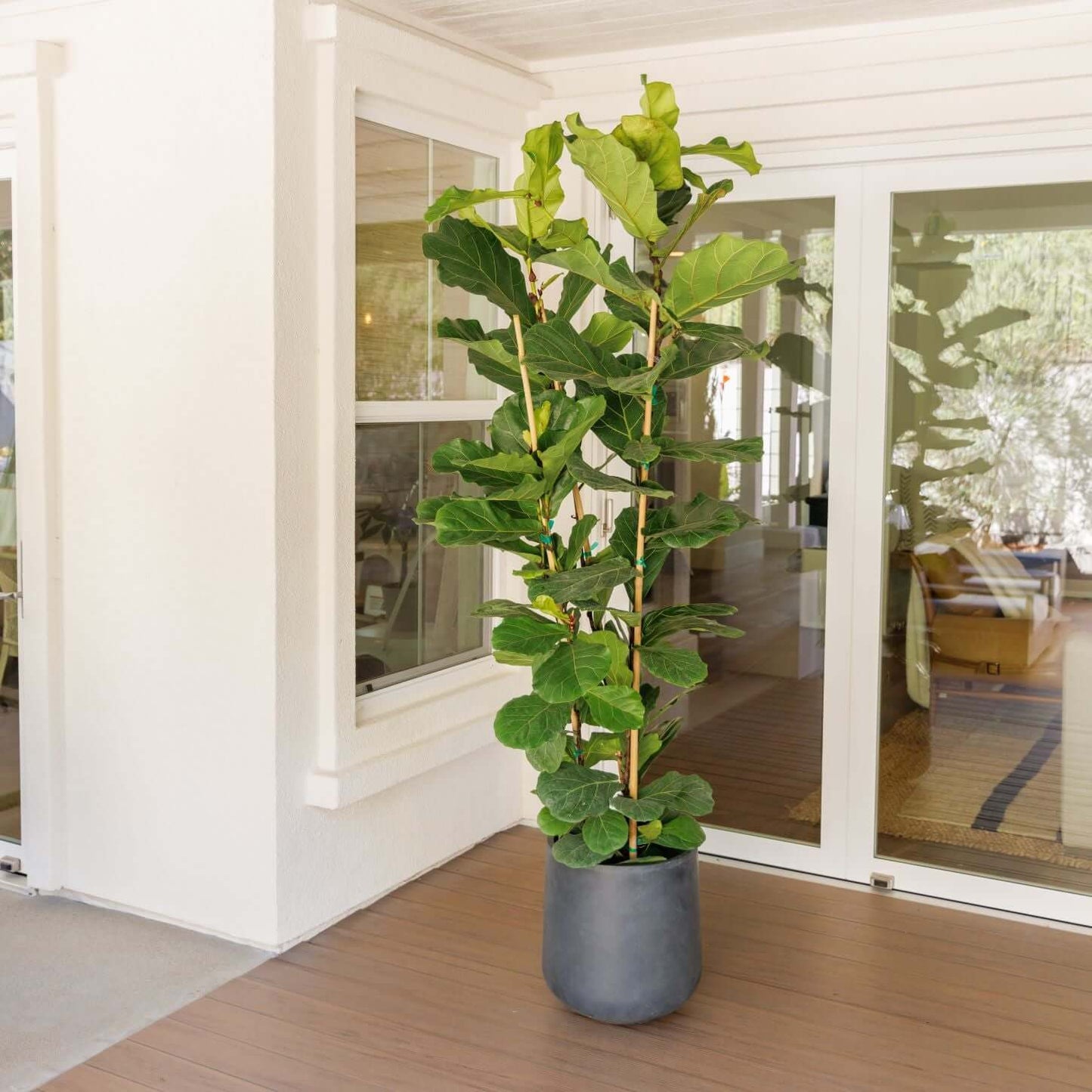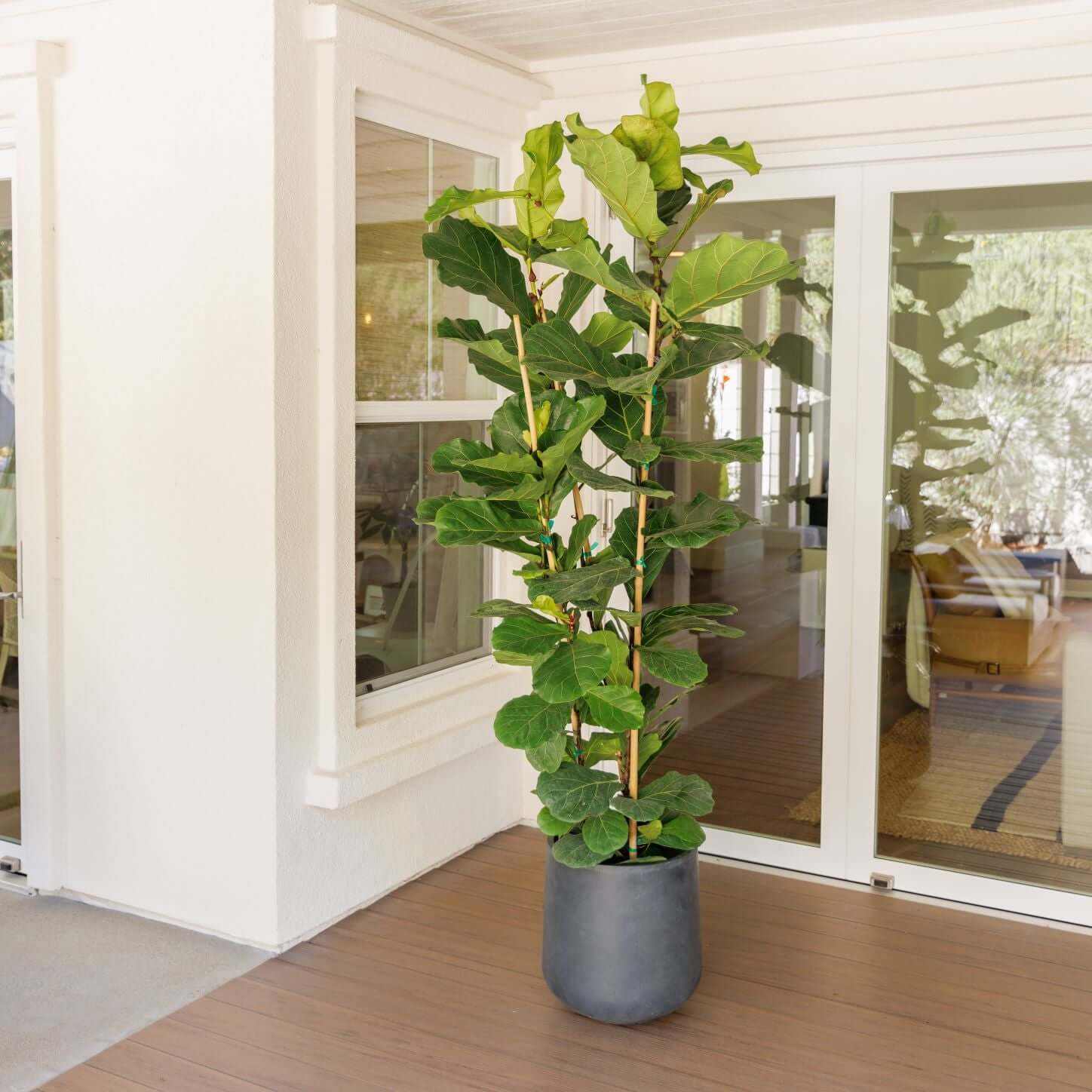Ficus lyrata (F. pandurata)
Orders over $399 are delivered for free! All others have a flat rate delivery fee of $30.
Fiddle Leaf Fig Tree
Fiddle Leaf Fig Tree
Ficus lyrata (F. pandurata)
Couldn't load pickup availability
The Ficus lyrata, commonly known as the Fiddle-Leaf Fig, is a striking indoor plant that can add a touch of the tropics to any home. With its large, violin-shaped leaves that grow upright, this plant is a statement piece ideal for floor-standing containers. In its native tropical habitats, it can reach heights of 40 feet or more, but indoors, it's manageable at around 6 feet or more, making it perfect for spacious rooms with high ceilings.
The impressive fiddle-shaped leaves can grow to a stunning 12-15 inches long and 8-10 inches wide, comparable to the size of a small violin. While Ficus lyrata thrives in tropical, warm, humid conditions, it can be grown outdoors in Southern California if sheltered from the wind and in frost-free climates.
As an indoor plant, the Fiddle Leaf Fig tree adds a bold, architectural element to any room. Its lush foliage and stunning structure make it a popular choice that compliments any design style. It enjoys bright, filtered light and can tolerate some direct sunlight, especially when placed near an eastern-facing window. Its robust nature allows it to withstand varying conditions, making it a relatively easy plant to care for, provided it’s given a stable spot where it can bask in the light.
Maintaining the health and beauty of your Ficus lyrata is straightforward. Ensure the soil remains moist but not waterlogged, allowing the top inch to dry out between waterings. This plant benefits from a good, fast-draining potting mix and appreciates a seasonal application of indoor fertilizer to support its vigorous growth. Regular dusting of the leaves with a soft cloth will keep them looking their best and allow for optimal light absorption.
The Fiddle-Leaf Fig is a resilient, striking plant that can transform any indoor space into a tropical oasis. With its dramatic foliage, easy-care requirements, and adaptability, it’s no wonder this plant is a popular houseplant. Give your Ficus lyrata the right conditions, and it will reward you with lush, vibrant growth for years to come.
The Fiddle Leaf Fig, also known as Ficus lyrata, is a popular indoor plant that requires bright, indirect light and well-draining soil to thrive. It also needs consistent watering and occasional fertilization to maintain its growth and health.
Ficus lyrata requires bright, indirect light to grow well. Place the plant near a window with filtered light, and avoid placing it in direct sunlight. The plant prefers well-draining soil that is rich in organic matter. A good potting mix should contain peat moss, perlite, and sand to provide good drainage and aeration for the roots.
Water the Fiddle Leaf Fig thoroughly whenever the top inch of soil feels dry to the touch. Avoid overwatering, as the plant is susceptible to root rot. During the growing season, from spring to fall, fertilize the plant monthly with a balanced liquid fertilizer. In the winter, reduce the frequency of fertilization to every other month.
Pruning the Fiddle Leaf Fig is essential to maintain its shape and encourage new growth. Trim back any damaged or yellowing leaves as soon as possible. Use sharp, clean pruning shears to make clean cuts, and avoid cutting into healthy tissue. If the plant becomes too tall or leggy, prune the top branches to encourage bushier growth.
Ficus lyrata is sensitive to changes in light and temperature. Sudden temperature drops or exposure to drafts can cause leaf drop and stunted growth. The plant also goes through a dormant period during the winter months, during which it may require less water and fertilization. The plant may be susceptible to pests such as spider mites, mealybugs, and scale insects. Regularly inspect the plant for signs of infestation, and treat any problems immediately.
The Fiddle Leaf Fig is a beautiful and rewarding indoor plant that requires attention and care to thrive. It needs bright, indirect light and well-draining soil, regular watering, and occasional fertilization. Pruning and maintenance are essential to maintain the plant's shape and encourage new growth. Be aware of environmental factors that can affect the plant's growth, such as light intensity, temperature, and pests. With proper care, Ficus lyrata can be a stunning addition to any indoor space.
- Everything Plants Express delivers is GROWN IN CALIFORNIA, FOR CALIFORNIA.
- We source from the best growers, utilizing relationships that have lasted decades.
- Each plant is hand selected, carefully procured and monitored up until the moment our van arrives at your location.
Flat Rate
All orders have a flat rate delivery fee of $30.
Quality
Delivering premium quality plants is a core value for everyone at Plants Express. Whether it is a small plant or a large tree, we use the appropriate vehicles and team members to deliver your order in a timely manner.
Q: How often should I water my Fiddle Leaf Fig?
A: Water your Fiddle Leaf Fig thoroughly whenever the top inch of soil feels dry to the touch. Avoid overwatering, as the plant is susceptible to root rot. During the dormant period in winter, water less frequently.
Q: Why are the leaves on my Fiddle Leaf Fig turning brown and falling off?
A: Brown and falling leaves can be caused by overwatering, underwatering, low humidity, or exposure to direct sunlight or cold drafts. Check the soil moisture, adjust watering frequency, and consider misting the leaves or using a humidifier to increase humidity.
Q: Can I propagate my Fiddle Leaf Fig?
A: Yes, Fiddle Leaf Figs can be propagated through stem cuttings. Take a cutting with several leaves and nodes, and root it in water or well-draining soil. It can take several weeks to several months for the cutting to develop roots and new growth.
Q: How often should I fertilize my Fiddle Leaf Fig?
A: During the growing season, from spring to fall, fertilize the Fiddle Leaf Fig monthly with a balanced liquid fertilizer. In the winter, reduce the frequency of fertilization to every other month.
Q: How do I prevent pests on my Fiddle Leaf Fig?
A: Regularly inspect the plant for signs of infestation, such as webbing or white powdery residue. Isolate the plant and treat any pests with a gentle insecticide or by wiping down the leaves with a damp cloth. Keep the plant in a clean and well-ventilated area to prevent future infestations.
Do you need help?
Our friendly plant experts are here to help. Give us a call or chat with us now.


